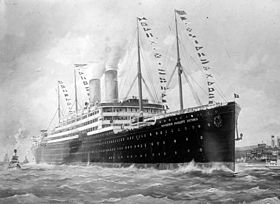Empress Auguste Viktoria (ship)
| Empress Auguste Viktoria | |
|---|---|
 Painting by Fred Pansing (before 1912) |
|
| Technical data (overview) | |
| Ship type: | Passenger ship |
| Purpose: | Liner service |
| Measurement: | 24,581 GRT 25,037 GRT after conversion |
| Length (o.a.): | 213 m |
| Width (above): | 23.5 m |
| Side height: | 16.5 m |
| Cruising speed: | 17.5 kn |
| Crew size: | 605 |
| Passenger Capacity: | 2,996 (1,897) |
| Construction year: | 1905 |
| Builder: | AG Vulcan Szczecin |
| Flag: | Germany, from 1921 Canada |
| Home port: | until 1919 Hamburg |
| Whereabouts: | Wrecked in Blyth in 1930/31 |
| Call sign: | |
| IMO number: | |
The Kaiserin Auguste Viktoria was a German express steamer owned by HAPAG and the largest ship in the world when it was commissioned . In the 1920s she sailed under the Canadian flag as the Empress of Scotland .
history
The steamboat was launched on 29 August 1905 with the hull number 264 on the Vulcanwerft in Szczecin from the stack . Instead of Europe , as originally planned, the ship was named Kaiserin Auguste Viktoria . The reason was the presence of the German imperial couple at the ship christening , which was carried out by the empress herself.
On May 10, 1906, the ship left Hamburg for its first voyage to New York . Because of their luxurious interior which was empress in the North Atlantic - travelers quickly become very popular.
At the beginning of November 1910, the Empress Auguste Viktoria made the first attempt to take off an airplane from a ship. An airplane was to take off 50 nautical miles from New York from a wooden launch pad built on the bow of the ship, with the intention of accelerating mail between Europe and North America. The start had to be canceled due to unfavorable weather conditions.
In 1914, after eight years of voyage, the Empress Auguste Viktoria had to be laid up in Hamburg , as the ship could not be used during the First World War . After the war it was delivered to Great Britain as a reparation payment in March 1919 . First, the Empress Auguste Viktoria was chartered by the US Shipping Board as a troop transport for the repatriation of American soldiers from Europe. In 1920 she drove for the Cunard Line between Liverpool and New York.
On May 13, 1921, she was sold to the Canadian Pacific Railways Company and renamed the Empress of Scotland . For this purpose it was overhauled at the Szczecin Vulcan shipyard and converted to oil firing. At the same time, the tonnage was increased by 500 tons and the passenger capacity was reduced by around 1000. On January 22, 1922, she drove from Southampton to New York, where she was chartered for a cruise to the Mediterranean . After her return she was used on the route Southampton - Cherbourg - Québec , which was soon expanded to include Hamburg. In Hamburg in 1923 there was a collision with the steamship Bonus , which required light repairs on the Empress of Scotland .
At the end of the 1920s, the operation of the ship became increasingly uneconomical, despite the introduction of a tourist class. After all, it was on December 2, 1930 Hughes, Bolckow & Co in Blyth sold for demolition. Initially, it was opened for viewing in order to sell the interior. On December 10, there was a fire on board that spread from the stern . Extinguishing attempts by more than 100 firefighters were unsuccessful. Since the Empress of Scotland could no longer be towed into the River Blyth, she was sunk at the berth. The remains of the ship were lifted over the following year. While trying to drag her into a dock , the ship's hull broke. The demolition work ended in October 1931.
technology
The Empress Auguste Viktoria was powered by two quadruple expansion machines with a total output of 12,880 kW , which worked on two four- bladed propellers , each 6.7 meters in diameter. Nine boilers with a total of 51 fires were used to generate steam .
See also
- Augusta Victoria , a high-speed steamer with a similar name, built in 1888 and running for HAPAG until 1904.
literature
- Robert D. Ballard , Ken Marschall : Lost Liners - From the Titanic to Andrea Doria - the glory and decline of the great luxury liners . Wilhelm Heyne Verlag GmbH & Co., Munich 1997, ISBN 3-453-12905-9 (English: Lost Liners: From the Titanic to the Andrea Doria. The ocean floor reveals its greatest lost ships. Translated by Helmut Gerstberger).
- Alfred Dudszus, Alfred Köpcke: The big book of ship types. Steam ships, motor ships, marine technology from the beginnings of machine-driven ships to the present day. transpress Pietsch, Berlin Stuttgart 1990, ISBN 3-344-00374-7 , pp. 168-169.
Web links
- Henrik Ljungström: Empress Auguste Victoria / Empress of Scotland (I). Retrieved September 24, 2009 .